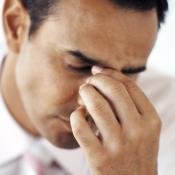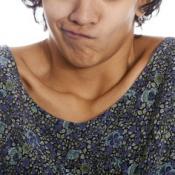 Do you feel compelled to remove flakes of dead skin from your nose? Do you have a hard time keeping your hands off pimples and blackheads? What about those random bumps on your arm that arise unexpectedly? For people diagnosed with excoriation disorder, skin picking is a common response to these and other generally harmless skin irritants.
Do you feel compelled to remove flakes of dead skin from your nose? Do you have a hard time keeping your hands off pimples and blackheads? What about those random bumps on your arm that arise unexpectedly? For people diagnosed with excoriation disorder, skin picking is a common response to these and other generally harmless skin irritants.
According to the fifth edition of the Diagnostic and Statistical Manual of Mental Disorders, excoriation—which falls under the umbrella of obsessive compulsion—is characterized by recurrent skin picking resulting in some sort of skin lesion; repeated attempts to stop the picking; potential impairment or distress over the picking; and an inability to attribute the skin picking to a medical condition, substance abuse, or another mental health diagnosis. Like hair pulling and nail biting, research suggests that excoriation may be a body-focused repetitive behavior (BFRB).
Most people who pick can typically find multiple sites on their body to pick, squeeze, or scratch. It is often a search-and-find mission using fingernails or some other designated instrument. The result of the picking can be inflamed, red, and sometimes bloody skin. When scabs develop, they may represent another reason to pick.
People who pick their skin often are ashamed and feel the need to conceal excoriation through the use of makeup, extra clothing, or hats. The shame may add to the distress they feel regarding their appearance or their behavior toward their body. Often, there is an undercurrent of perfectionism with BFRBs, especially skin picking, and a deeply held belief that any imperfections must be eliminated.
Often, therapy will address underlying feelings and emotions that fuel the behavior, exploration of triggers that affect when and where the person picks, and soothing strategies to deescalate compulsive behaviors.
Would you be surprised to know that more than 75% of people diagnosed with excoriation are female? It is estimated that excoriation affects 1.4% of the general population, although many experts think the number may be higher. Most often, the condition begins at the onset of puberty and becomes chronic over time.
Skin picking may be triggered by tension, stress, or boredom and often has a compulsive element to it, meaning the person cannot stop themselves from picking and feels compelled to either relieve uncomfortable feelings or respond to minor skin irritations. Most often it occurs without full awareness of the behavior and when the person is alone. While reading, studying, on the phone, or watching television are all common scenarios for excoriation to occur. Many people spend up to one hour per day picking or resisting the urge to pick. Often, another person has noticed and mentioned the behavior.
Treatment for skin picking is often found in cognitive behavioral therapy, dialectical behavior therapy, rational emotive behavioral therapy, or acceptance and commitment therapy facilitated by a licensed mental health provider. Often, therapy will address underlying feelings and emotions that fuel the behavior, exploration of triggers that affect when and where the person picks, and soothing strategies to deescalate compulsive behaviors.
Those with BFRBs may also find relief with tactile and meditative strategies. Tactile replacements may be helpful in providing substitute relief and can include bubble-wrap popping, fidget toys, cooking, working with clay, painting, or even using a piece of ribbon as a soothing instrument to wrap, rip, and stroke. Meditative behaviors such as yoga, cleaning, walking, or listening to music can also be effective in soothing the urge to pick.
Although excoriation is a complicated and often distressing behavior, it is manageable with professional treatment and replacement behaviors.
References:
- American Psychiatric Association. (2013). Diagnostic and Statistical Manual of Mental Disorders (5th ed.). Washington, DC: Author.
- OCD & Related Disorders Program. (n.d.). Excoriation. Retrieved from https://mghocd.org/clinical-services/excoriation/

The preceding article was solely written by the author named above. Any views and opinions expressed are not necessarily shared by GoodTherapy.org. Questions or concerns about the preceding article can be directed to the author or posted as a comment below.

 Orthorexia: An Obsessive Relationship with Healthy Eating
Orthorexia: An Obsessive Relationship with Healthy Eating Getting Off the Merry-Go-Round: Managing Obsessive Thoughts
Getting Off the Merry-Go-Round: Managing Obsessive Thoughts Ever Wondered Why You Bite the Insides of Your Cheeks?
Ever Wondered Why You Bite the Insides of Your Cheeks?

Please fill out all required fields to submit your message.
Invalid Email Address.
Please confirm that you are human.
Leave a Comment
By commenting you acknowledge acceptance of GoodTherapy.org's Terms and Conditions of Use.